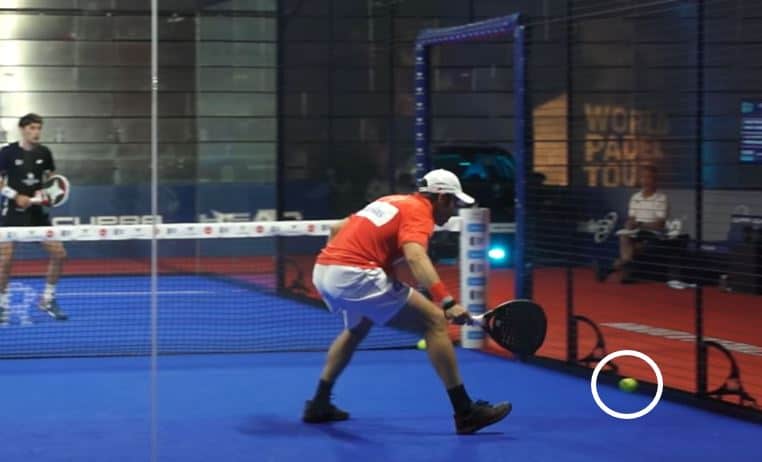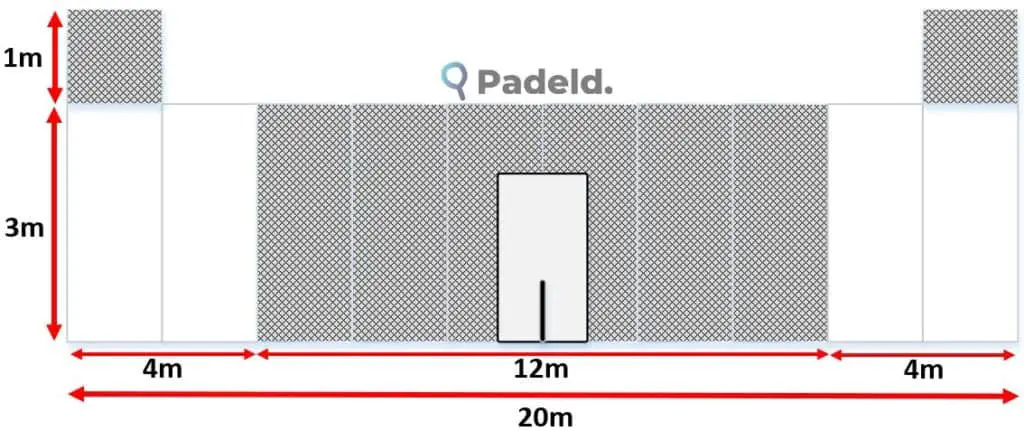Padel courts are surrounded by a cage-like enclosure that is made from various different materials. Some of the walls are made from glass, and these cause the ball to bounce in a very consistent way when it hits them. Some of the other walls are made from a metallic fence-like material, which can cause the ball to bounce in an irregular manner.
Many newcomers to the sport have questions about these different kinds of surfaces, and therefore, in this post I will be explaining whether you can hit the ball off the fence in padel. I’ll take you through all the rules related to it, and I’ll also explain the strategy behind doing so! If any of that sounds like it’s going to be beneficial for you – feel free to read on!
So, can you hit the ball off the fence in padel?
You can hit the ball off the fence on your opponent’s side of the court, as long as the ball makes contact with the ground on that side of the court first. However, you cannot hit the ball off the fence on your own side of the court. Doing this would cause your opponent to win the point.
The only parts of the wall on your own side of the court that you’re allowed to hit the ball off are the glass sections. The glass sections are located all the way along the back wall, as well as four metres down each side wall too. You can see this in the diagram below! So, if you feel the need to, you can hit the ball directly into the glass walls, causing it to rebound and travel onto your opponent’s side of the net. You cannot do the same thing with the fence!

I feel examples may be needed to make all this a little clearer! Therefore, I’d like you to imagine that you were in the middle of a rally with your opponents. and you noticed that both players in the opposition team had drifted over to the right hand side of the court, leaving the left hand side wide open. The next time the ball came towards you, you aimed for the left hand side of the court and played a powerful forehand shot. Unfortunately, you hit the ball slightly too hard, causing it to cannon straight into the metal fence on the opponent’s side of the net without touching the ground first. In this case you would lose the point, because the ball needs to bounce on the ground before it touches the fence in order for the rally to continue!

As a second example, imagine you are stood on the right hand side of the court, and your opponent plays a great shot that goes low to your right. You react instinctively and attempt to return the ball by hitting it into the side wall of the court – which hopefully will cause it to rebound over the net back onto your opponent’s side of the court. Although you were aiming to hit the ball into the glass section of the side wall, you miscue the shot slightly and hit the ball into the metal fence instead. Sadly, this would cause you to lose the point, because on your own side of the court the only walls that you are allowed to hit the ball into are the glass ones!
What Are The Dimensions Of The Fence On A Padel Court?
Now that we know how and when you’re allowed to hit the fence during a padel match, I thought it would be useful to share how big the fence is – so that you know how big your target will be!

Above you can see my diagram of a side view of a padel court. The white sections are the glass walls, and the criss-cross grey sections represent the fence. The entire length of the side of a court is 20 metres, and each glass section in the side wall is approximately 4 metres long. This means that the main fenced section of the side wall is 12 metres in length, with a hole near the centre next to the net where players can enter and exit the court. You can also see that the main fenced section is 3 metres in height, so it’s quite a large area to target! If you’d like to read more about all of the different dimensions of a padel court – click here to read my in-depth post on that!
Can You Hit The Fence From A Serve In Padel?
When it comes to the serve, the rules for hitting the fence in padel are ever so slightly different to the ones that I’ve just described. Under the normal rules, the ball can hit the fence on the opponent’s side of the court after it has bounced once on that side of the court. However, when you hit a serve, the ball is not allowed to hit the fence on the side wall even if it has bounced once already. The only time the ball is allowed to hit the fence directly from a serve is if the ball has already bounced twice and the point is over – which is an extremely rare occurrence as opposition players do not tend to let the ball bounce twice directly from the serve.
If you do hit the fence directly from a serve, or after the ball has bounced once, this will be called as a fault by the umpire. This means that you must serve again in order to get the ball in play in the correct way. If you serve another fault on your second serve, you will lose the point.
Taking all of this into account, I’d try to aim for the back or the middle line of the receiving box when serving – especially if you don’t feel like you have great control over where your serve goes. If you aim too close to the wall and misjudge your shot slightly, the ball can easily end up hitting the metal fence and costing you a first serve!
What Are The Advantages Of Hitting The Ball Off The Fence?
The main advantages of hitting the ball into the fence is that the surface of the fence is dramatically different to the glass walls that are featured elsewhere on the court. As I mentioned earlier, the glass walls are completely flat, which means that the ball is more likely to bounce in a consistent way when it makes contact with those surfaces. However, the fences aren’t completely flat. They have a mesh-like surface, with little holes in between the metal that is used to construct the fence. This uneven surface can mean that the ball will hit the fence and bounce off at strange angles that cannot be predicted by the players. If the players can’t predict exactly how the ball is going to bounce, then they cannot get themselves in good positions to play their shot. Basically, hitting the ball into the fence can introduce a little variation in bounce that can catch your opponents off guard.
In addition to the more irregular bounce characteristics provided by the fence, padel players are also a lot less used to seeing the ball bouncing off the fence. The majority of the time that the ball hits a wall on a padel court, it is making contact with the glass walls towards the back end of the court. This means that padel players are much better trained in getting into position when the ball is hitting those walls. If you can target the fence at the side of the court more, then players will not be as confident in predicting where the ball is going to bounce, and as a result they may not be as well prepared to return your shots.
When Should You Target The Fence?
During the course of a point, there are certain times when it’s more beneficial than others to hit the ball off the fence on the opponent’s side of the court. Here are a few of them:
- When you’re in control of the point at the net – If you and your partner are commanding the centre of the court, it can often be a good idea to play a quick shot into the ground and then into the fence at the side of the court. This can catch your opponents off guard and if the ball bounces awkwardly off the fence this can be even more beneficial
- When you see your opponents in poor court position – During a point it’s common for players to get themselves out of position as they move around the court to cover certain shots. If both players on the other team move too far across to one side of the court, a quick shot towards the other side of the court that bounces into the fence may be a good play to make. Once again, if the ball bounces awkwardly off the fence this could make this shot even more difficult to deal with
- When you have an opportunity for a smash at the net – If you’re stood close to the net on one side of the court and the ball goes high up in the air, then you’ll have an opportunity to play a smash shot. Most smash shots target the back wall of the court, but if the angle is correct then you could potentially play a smash into the fence on the side of the court. This can cause the ball to bounce at a difficult angle that they don’t usually have to deal with!

Conclusion
I hope that after reading this post you feel like you have a much better grasp of the rules relating to hitting the ball off the fence in padel. Knowing these rules is key to understanding and playing the game and knowing how to make best use of the fence could be an important factor in winning more points on the court!
If you enjoyed this post, keep an eye on Padeld.com as I’ll have plenty more posts like this coming up. I’ll also be sharing more technical and strategic tips too! Thanks for reading!
